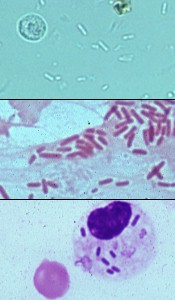Bacteria can be identified in unstained urine sediments when present in sufficient numbers.
 Rod-shaped bacteria and chains of cocci are often readily identifiable. The images at right show
E.coli bacilli from a case of cystitis in a dog. However, small amorphous crystals,
cellular debris, and small fat droplets can either mask or mimic cocci.
If there is any doubt about the presence of bacteria, a Gram-stained smear of urine sediment
(middle panel) should be examined.
Rod-shaped bacteria and chains of cocci are often readily identifiable. The images at right show
E.coli bacilli from a case of cystitis in a dog. However, small amorphous crystals,
cellular debris, and small fat droplets can either mask or mimic cocci.
If there is any doubt about the presence of bacteria, a Gram-stained smear of urine sediment
(middle panel) should be examined.
Urine in the bladder of normal animals is sterile. Though bacteria from the distal urethra and/or genital tract may contaminate voided specimens, they are usually too few to see if a good mid-stream collection was obtained. Although phagocytized bacteria cannot be seen in unstained wet mounts of urine sediment, they may found in stained smears of sediment. The lower panel at the right shows a neutrophil containing phagocytized bacteria. Notice that the nucleus in this cell is round; nuclei tend to become round as neutrophils age in urine. Bacteriuria of clinical significance, e.g., bacterial cystitis, is usually accompanied by increased numbers of white cells (pyuria). The presence of a few bacteria without pyuria is very rarely significant of infection. |
Last updated: August 28, 1997